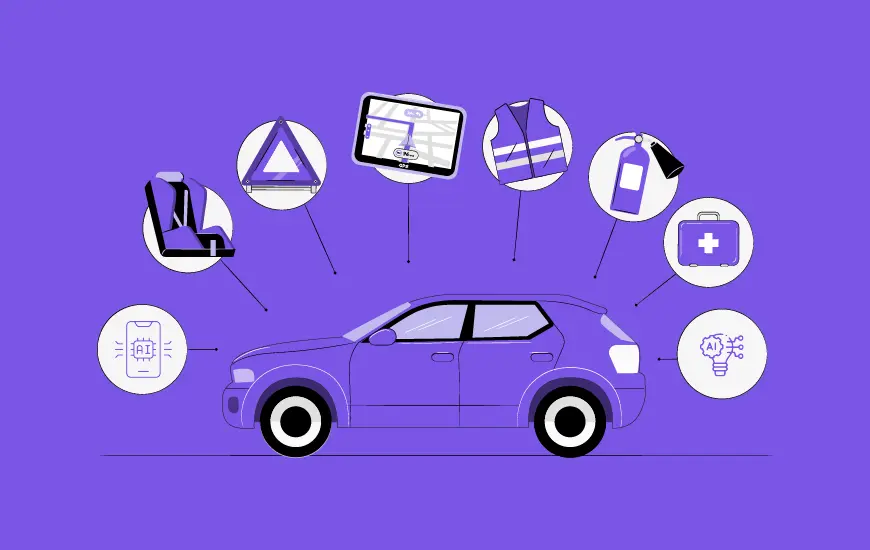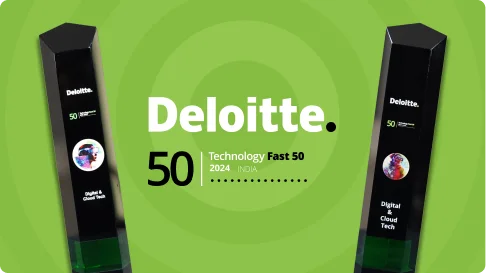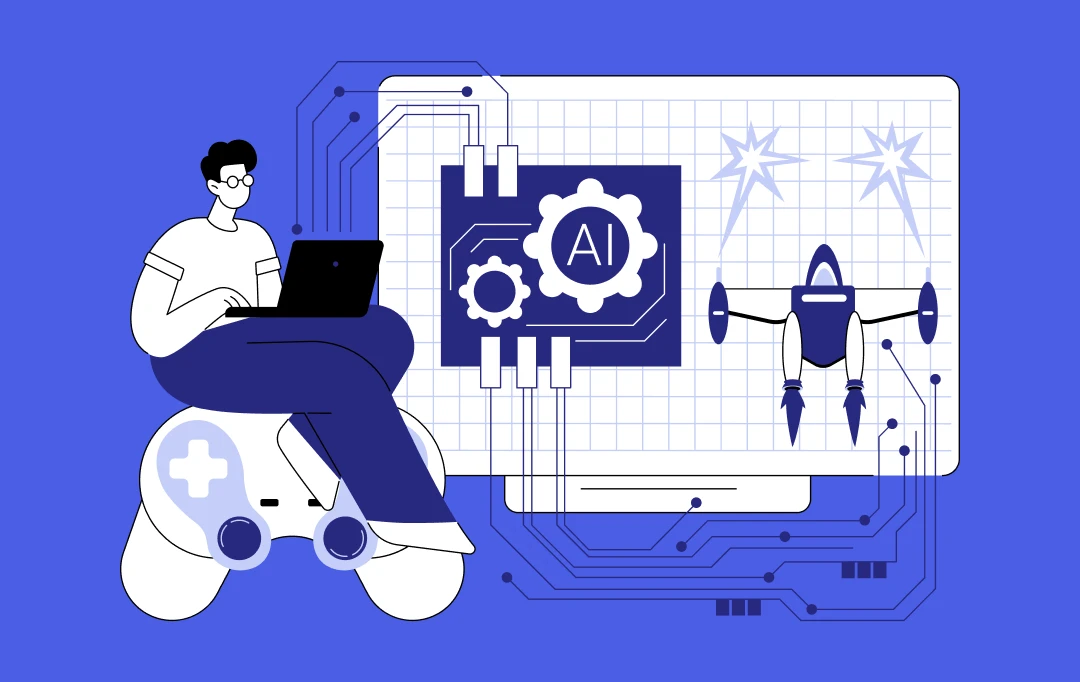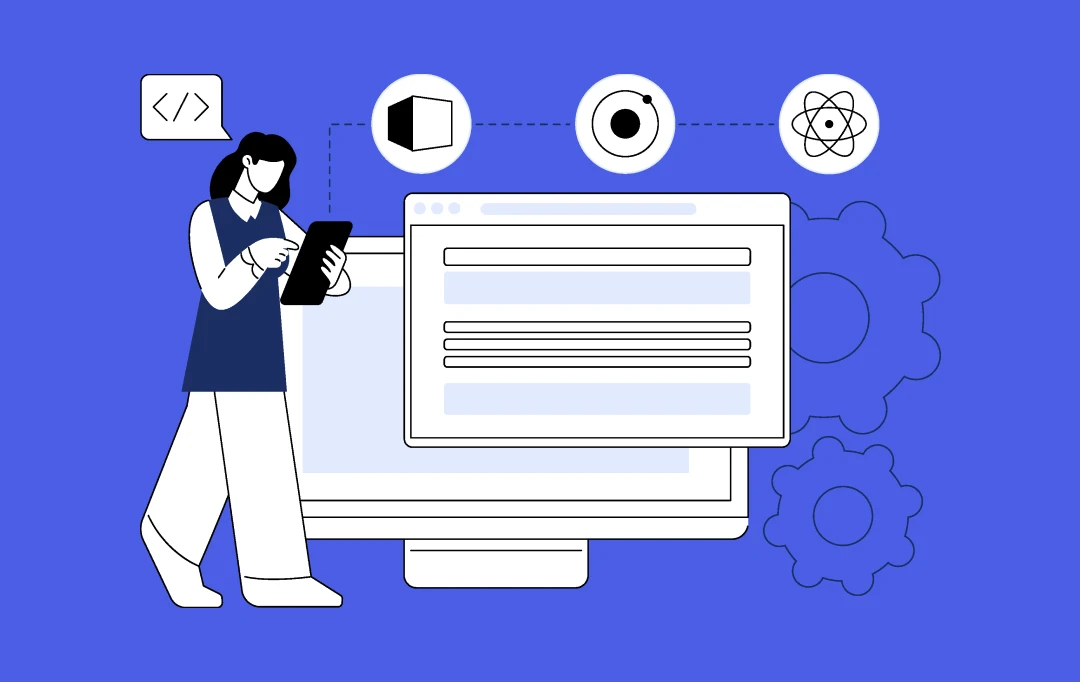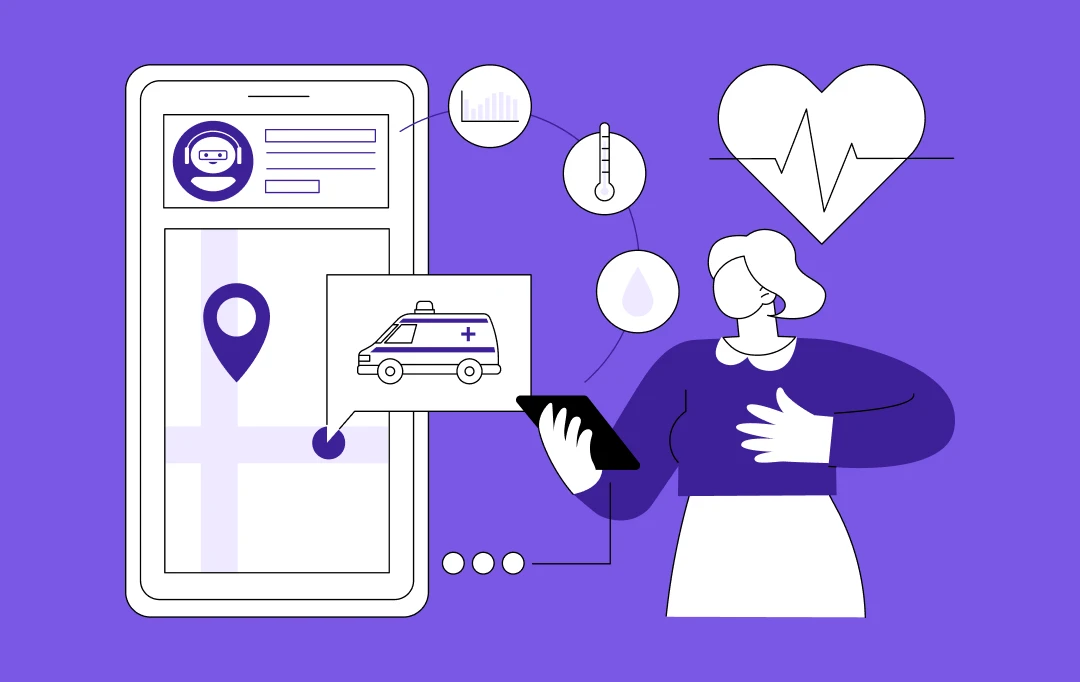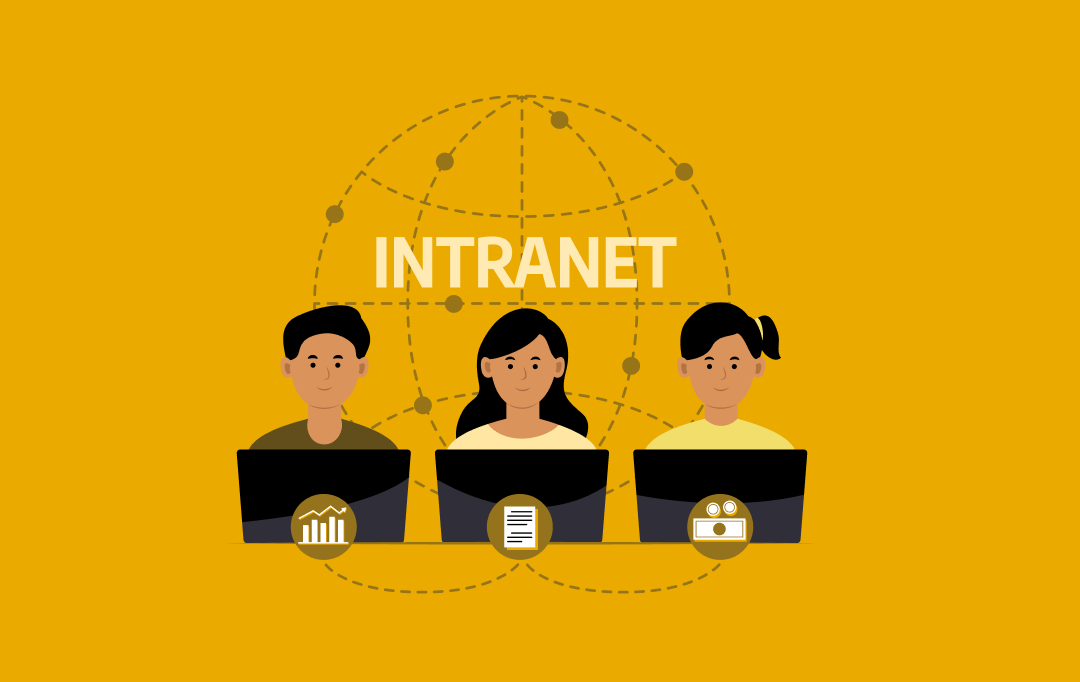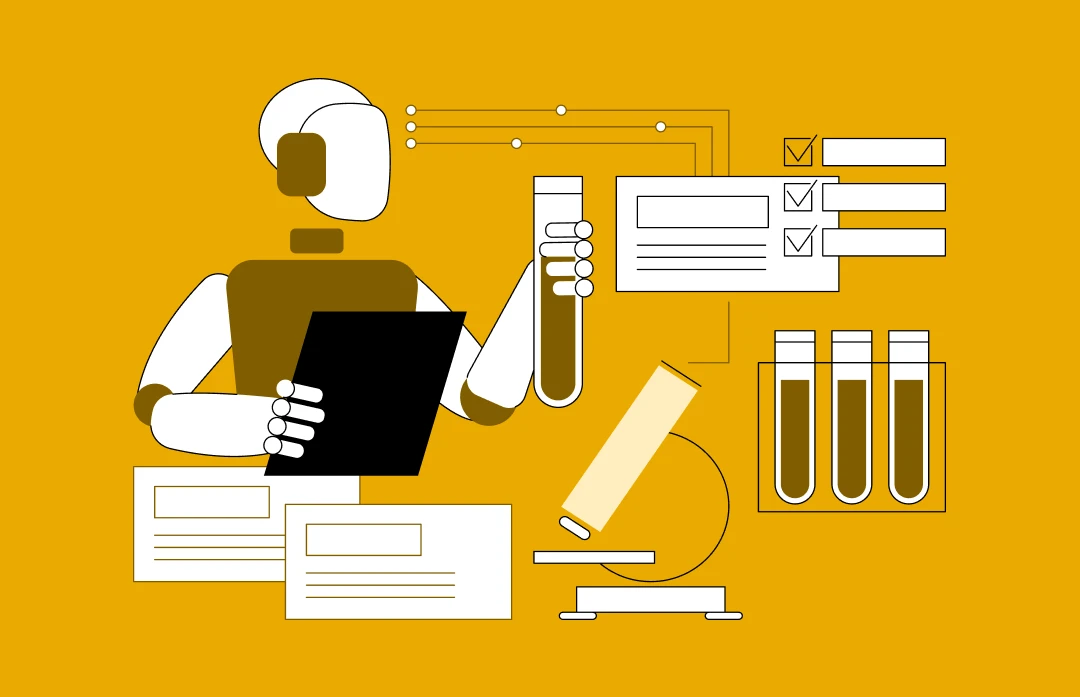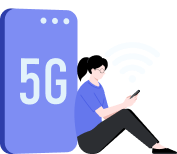- Industry-Wise Use Cases of 5G: Specific to Australian Businesses
- Smart Retail Stores
- Smart Manufacturing
- Fleet Management & Logistics
- Smart Cities & Infrastructure
- Automation in Agriculture
- Cybersecurity-Enhanced Networks
- Port Automation in Logistics
- 5G-Powered Enhanced Tourism
- 5G-Enabled Aviation Industry
- Benefits of 5G for key Australian Industries
- Faster Speeds and Lower Latency
- Increased Capacity and Connectivity
- Enhanced Productivity and Efficiency
- Innovation and New Business Models
- Improved Reliability and Security
- Support for Regional and Remote Businesses
- Making Apps Optimized for 5G: What to Know
- Optimizing App Architecture for 5G Speed/Bandwidth
- Developing Scalable Apps for IoT Support
- Utilizing Network Slicing
- Steps to Adopt 5G Network in Mobile Apps
- Understanding the Use Case
- Analyzing 5G Network Connectivity
- Backend Infrastructure Update
- Redesigning App Architecture
- Testing in Real 5G Environments
- How Appinventiv Can Assist You in Utilizing 5G Network For Your Business
- FAQs
Key takeaways:
- Industry Transformation: 5G is revolutionizing key sectors in Australia, including healthcare, manufacturing, agriculture, and logistics, by enabling real-time data processing, enhanced connectivity, and automation that improve operational efficiency and customer experiences.
- Enhanced Connectivity for Regional Areas: 5G technology bridges the connectivity gap in remote and regional areas of Australia, supporting industries like agriculture and mining with real-time monitoring, IoT integration, and automation, ensuring that businesses in these areas stay competitive and future-ready.
- Improved Efficiency and Innovation: With ultra-low latency and high bandwidth, 5G unlocks innovations such as smart cities, autonomous vehicles, and AI-powered solutions, fostering new business models and enhancing existing operations across Australian industries.
Australia is not new to adopting next-gen innovations, and has always thrived on staying ahead of the curve. In 2019, when 5G infrastructure first entered Australia, it promised fast speeds and ultra-low latency. Yet, Australian businesses have struggled to take tangible actions to reap the advantages of the 5G network. According to a report published by Deloitte, there were some major reasons for such a prohibitive growth since 5G deployment:
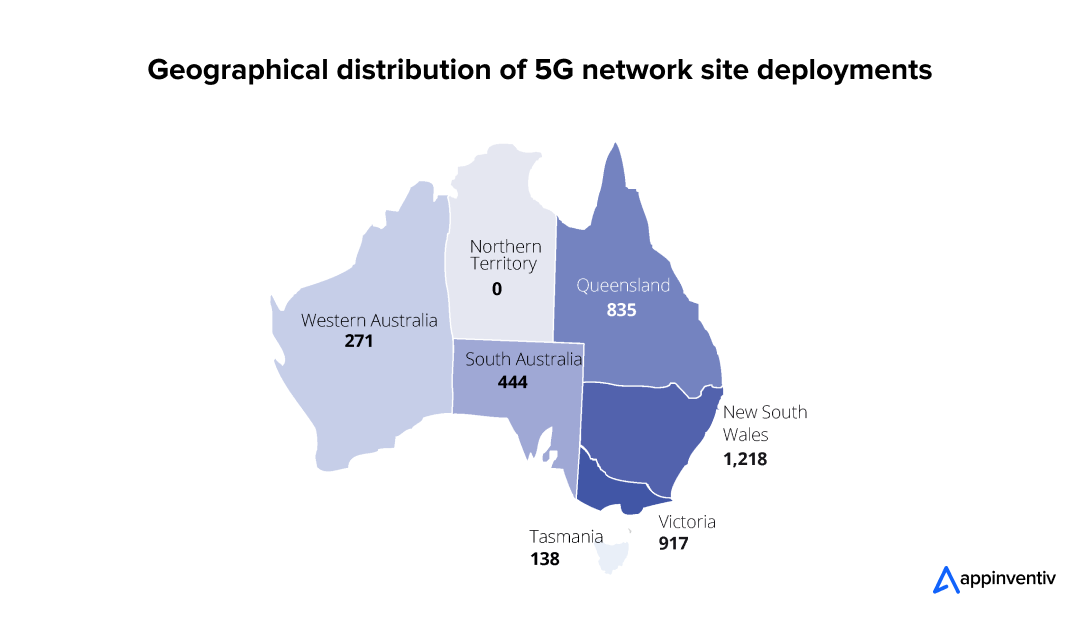
Australia is not new to adopting next-gen innovations, and has always thrived on staying ahead of the curve. In 2019, when 5G infrastructure first entered Australia, it promised fast speeds and ultra-low latency. Yet, Australian businesses have struggled to take tangible actions to reap the advantages of the 5G network. According to a report published by Deloitte, there were some major reasons for such a prohibitive growth since 5G deployment:
- In regional areas, rolling out 5G infrastructure became cost-prohibitive due to high backhaul costs and lower population density.
- Around 59% of businesses lacked a 5G strategy, and a further 30% had no plans to implement it.
- Highly inconsistent planning approval processes
However, the scenario took a turn in 2025.
According to Cenerva, Australia is now emerging as a key player in the global expansion of private 5G networks. Deployment efforts further enhance the context, as the Australian Grand Prix Corporation has installed a private 5G network at the Albert Park Street Circuit in Melbourne to support infrastructural operations during the 2025 Formula 1 Grand Prix.
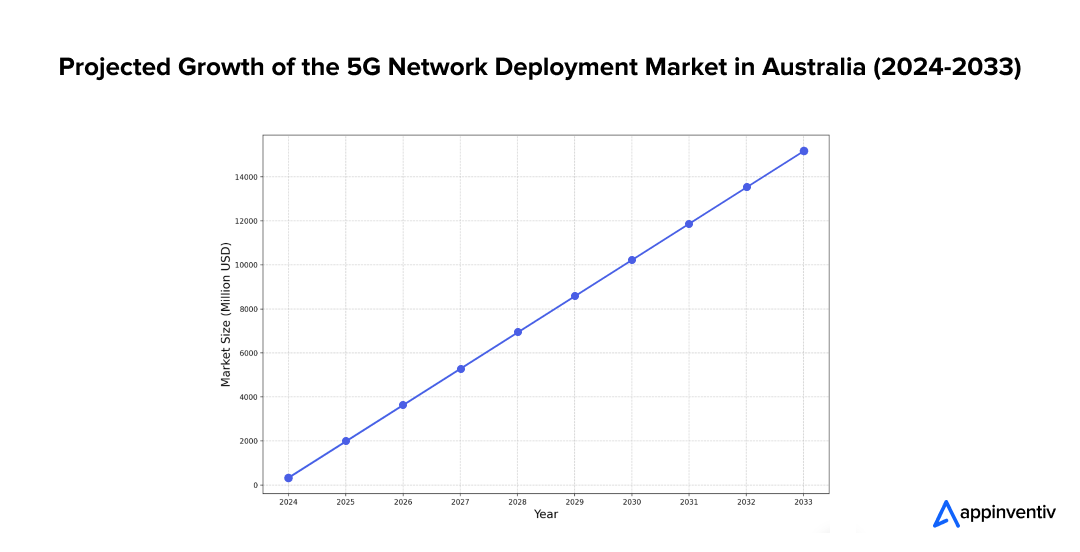
A market analysis conducted by the IMARC group revealed that the Australian 5G network deployment market reached $341.87 million in 2024 and is expected to reach $15.16 billion by 2033. This demonstrates how the Australian landscape is poised for strategic 5G deployment across its entire region.
Considering the above stats, this blog will discuss 5G use cases for Australian businesses that can transform the Australian business landscape entirely.
Industry-Wise Use Cases of 5G: Specific to Australian Businesses
AI in Australia is driving advancements in trending technologies, such as 5G, by enhancing network optimization, enabling real-time data processing, and supporting innovative applications. AI algorithms improve 5G network efficiency through predictive maintenance and traffic management, ensuring low latency and high capacity.
This synergy powers technologies such as autonomous vehicles, smart cities, and the Internet of Things (IoT), where AI analyzes vast data streams transmitted via 5 G networks.
For instance, AI in autonomous cars leverages 5G’s speed for safe navigation. Additionally, Australia’s $17 million AI Adoption Programme fosters AI-5G integration, boosting industries such as healthcare and gaming.
“5G will fundamentally change the way we live and work. It is critical for Australia’s digital future”.
By Andy Penn, former CEO of Telstra
5G isn’t just a technological upgrade; it is a total game changer in terms of speed and bandwidth. From smart manufacturing and fleet management to smart cities and agricultural automation, the benefits are immense.
Let’s break it down how 5G applications in Aussie business are showing up across sectors and why, finally, it’s getting to that stage where it is meant to.
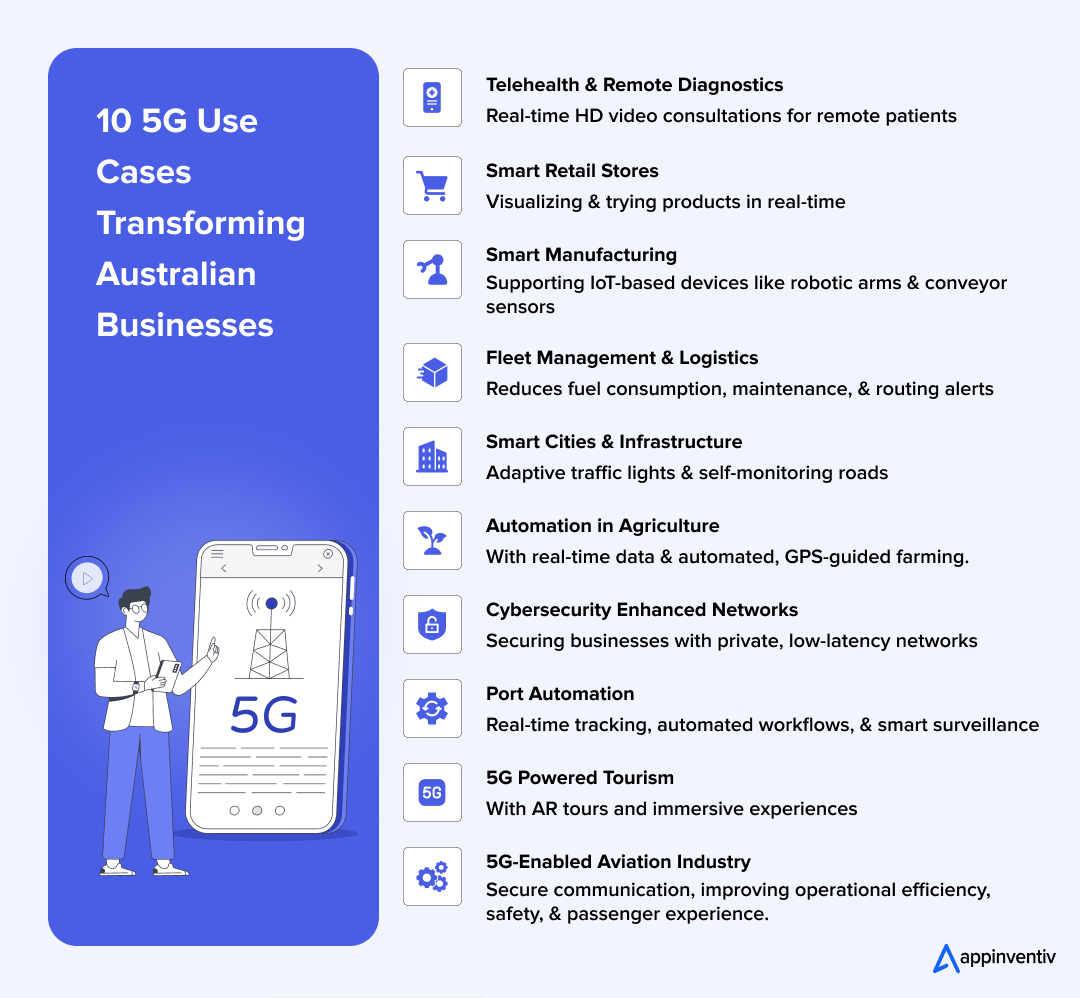 Telehealth & Remote Diagnostics
Telehealth & Remote Diagnostics
Access to quality healthcare is not an advantage, but a necessity. In a region, remote communities can be located hundreds of miles apart, and healthcare software development in Australia, backed by tech trends like 5G, is helping bridge that gap. Thanks to its high speed and low latency, 5G enables HD video conferencing, which makes a doctor’s availability accessible to these communities.
- High-Speed Data Transfer: Enables rapid transmission of large medical files (e.g., MRI scans, X-rays) for quick diagnostics.
- IoT Device Integration: IoT in healthcare powers wearable devices and sensors for continuous, real-time health monitoring (e.g., heart rate, blood pressure).
- Reliable Connectivity: Ensures stable connections for uninterrupted telehealth sessions, even in remote areas.
- Enhanced AR/VR: Supports augmented/virtual reality for immersive medical training or patient consultations.
- Real-Time Analytics: Data analytics in healthcare enables instant processing of health data for faster clinical decisions.
For example, Queensland Health has also implemented a telehealth strategy, leveraging the advantages of 5G networks to support patients of the indigenous communities. For instance, a patient uses a remote monitoring app to track his condition. His vital signs data is transmitted in real time to the hospital, which can virtually initiate consultations, as required.
Smart Retail Stores
Australia’s retail landscape is expected to benefit from the prominent use cases of 5G. Smart retail stores powered by 5G enhance operations and customer experiences through high-speed, low-latency, and reliable connectivity. Here’s how it’s practically applied:
- Real-time inventory management: 5G unlocks the power of AI in inventory management. 5G enables IoT sensors to track stock levels instantly, updating systems to prevent shortages or overstocking.
- Robotics and automation: Facilitate real-time communication for robots restocking shelves or assisting customers, thereby improving efficiency.
- Smart checkouts: Power contactless payment systems and automated checkouts, reducing wait times with fast data processing.
- Enhanced customer experiences: Supports AR/VR for virtual try-ons or product demos, delivering seamless, immersive interactions.
- Personalized marketing: Connects AI-driven analytics to customer devices, offering tailored promotions via real-time data exchange.
Bonus Read: How Much Does It Cost to Build an On-Demand Retail Delivery App Like Woolworths?
Smart Manufacturing
The Australian manufacturing sector is undergoing a revolution, thanks to 5G. Ultra-low latency, high device density, and excellent real-time communication as advantages of 5G networks that could unlock multifold benefits for Aussie businesses. But how are smart factories utilizing 5G?
- Real-time machine monitoring: 5G enables IoT sensors to track equipment performance instantly, reducing downtime through predictive maintenance.
- Digital twins: Powers real-time data feeds for virtual models of machinery or processes, optimizing performance and troubleshooting.
Bonus Read: Digital Twin in Manufacturing
- Augmented reality (AR) support: Enables AR for worker training or maintenance, overlaying real-time data on equipment via 5G-connected devices.
- Supply chain integration: Connects systems across the supply chain for real-time inventory tracking and demand forecasting.
- Quality control: Supports high-resolution cameras and AI for instant defect detection, ensuring product quality with minimal delays.
Fleet Management & Logistics
When matters revolve around fleet management in Australia, the real benefits of 5G for key Australian industries tend to surface. Thanks to its high speed and low latency connectivity, 5G is enhancing the automotive sector in the following ways:
- Real-Time Tracking: 5G enables precise, real-time GPS tracking of vehicles, improving route optimization and delivery accuracy.
- Enhanced Telematics: High bandwidth supports continuous data streaming from vehicle sensors, monitoring performance, fuel usage, and maintenance needs.
- Autonomous Vehicles: 5G supports vehicle-to-everything (V2X) communication, enabling self-driving trucks and coordinated fleet movements.
- Data Analytics: Fast data transfer allows real-time automotive analytics for predictive maintenance, traffic forecasting, and demand planning.
- IoT Integration: 5G connects IoT devices (e.g., cargo sensors) for monitoring temperature, humidity, or package conditions during transit.
- Safety Enhancements: Real-time video feeds and AI-driven analytics improve driver safety and incident response.
For instance, Qube is installing 5G communications to link their automated cargo vehicles at Moorebank Logistics Park, with ultra-low latency and high 5G reliability.
Similarly, HMI Technologies Australia is also trialling 5G technology to operate Autonomous Surface Vehicles (ASVs) for enhanced mobility solutions for the disabled and elderly.
Smart Cities & Infrastructure
Imagine an automated system in Australia where traffic lights adjust themselves in real-time, based on congestion. Sensors beneath the road inform about the pothole formation in advance. It’s not a distant dream but a direction of one of the many Australian LTE/5G use cases.
With its inherent capability to support massive IoT networks and data transmission with ultra-low latency, 5G enables multifold communication between thousands of connected devices and the sensors spread all over the city.
- Smart Buildings: 5G enables IoT devices for automated lighting, HVAC, and security, improving energy use.
- Traffic Management: Real-time traffic monitoring and adaptive signal control using connected sensors and cameras. Also, autonomous vehicles with V2X help reduce congestion and accidents.
- Public Services: High-speed connectivity supports e-governance, telehealth, and remote education.
- Environmental Monitoring: 5G-connected sensors track air quality, noise, and water levels for proactive interventions.
For example, the City of Melbourne has started a test on mobility applications to explore the benefits of 5G integration for fleet management, among the many prominent Australian LTE/5G use cases. This includes the installation of sensors in streets and parks, which are responsible for collecting data on pedestrian activity, pollution, humidity, and temperature to assess variables such as roadworks, traffic congestion, and extreme weather conditions.
Automation in Agriculture
Out of the many benefits of 5G for key Australian industries, one revolution is being driven by 5G. It is agricultural automation. Thanks to 5G, factors like high-speed rates and the network’s low latency are highly accessible to farmers. Now, they can rely on real-time data from sensors to manage their land with precise measurements.
- Real-Time Monitoring: 5G enables sensors and IoT devices to transmit soil, crop, and weather data instantly, allowing precise irrigation and fertilization.
- Autonomous Machinery: AI in agriculture supports driverless tractors and drones for planting, spraying, and harvesting with low-latency control.
- Livestock Management: Facilitates real-time tracking of animal health and location using connected wearables.
- Remote Operations: Farmers can manage equipment and monitor fields remotely via 5G-enabled devices, reducing labor costs.
- Supply Chain Efficiency: IoT in agriculture enhances tracking and automation in logistics, ensuring the timely delivery of produce.
For instance, Telstra and Ericson, in a joint partnership, deployed Australia’s first private 5G network for AgriFood Connect, marking Ericson’s first private 5G installation in Australia, supporting both LTE and 5G Standalone. It supports industrial IoT and tends to stream data directly from the machinery, enabling condition and predictive monitoring in real time. Located at AATLIS Science and Tech Park, it:
- Targets remote and regional areas of Australia, allowing localized data connectivity
- Supports Industry 4.0, positioning the solution as a blueprint for smart industry expansion.
Australia’s agriculture and advanced manufacturing industries will play a pivotal role in Australia’s economic growth. We are focused on supporting businesses in defining their challenges within the agri-food value chain… We identify the right solutions for companies in areas including digital transformation and operational enhancement. Utilising advanced technologies like the dedicated 5G network will help demonstrate the latest technological innovations.”
By Thomas Hall, chief executive at AgriFood Connect
Cybersecurity-Enhanced Networks
You must have come across the saying, “Data is the new currency.” It is true, considering today’s digital landscape, and further protecting that data is more important than ever. Specific to Australian business, the rise of 5G business use cases in Australia isn’t just related to higher speeds; it’s also about creating a secure digital fortress. Completely different from public networks, the benefits of dedicated bandwidth and ultra-low latency prove to be significant points to establish enterprise-grade communication channels successfully.
- Real-Time Threat Detection: 5G’s low latency enables rapid identification and response to cyber threats, minimizing damage from attacks like DDoS or malware.
- Secure IoT Ecosystems: Supports massive IoT device connectivity with enhanced encryption and authentication, ensuring secure communication for smart devices.
- Network Slicing for Isolation: Creates isolated virtual networks for sensitive applications, reducing the risk of cross-network attacks.
- Edge Computing Security: Edge computing in enterprises facilitates secure data processing at the edge, reducing the exposure of sensitive data during transmission.
- Enhanced Encryption: Leverages 5G’s advanced cryptographic protocols to protect data integrity and confidentiality across networks.
- AI-Driven Security Analytics: Supports AI and machine learning for real-time analysis of network traffic, detecting anomalies and potential threats instantly.
For example, Toyota Material Handling’s use of private 5G for their major production complex in Columbus, Indiana, USA helped them gain significant advantages. The organization achieved increased productivity, faster customer deliveries, and boosted employee morale. As the Australian market looks forward to 5G transforming business growth, cybersecurity will emerge as a built-in advantage, rather than a technical add-on.
Port Automation in Logistics
Thanks to 5G, the movement of goods at Sydney and Melbourne ports is becoming faster, more secure, and smarter. These hubs handle multiple containers daily, and 5G IoT is transforming how every one of those containers is tracked, managed, and protected. Earlier, port cranes and vehicles operated on outdated legacy systems, which are now being integrated into automated workflows via low-latency 5G networks.
- Real-Time Equipment Control: Enables precise remote operation of cranes, AGVs (Automated Guided Vehicles), and drones with ultra-low latency.
- IoT and Sensor Integration: Supports massive IoT deployments for real-time monitoring of cargo, equipment, and environmental conditions.
- Enhanced Data Analytics: Facilitates rapid data transfer for AI-driven analytics to optimize container handling and predict maintenance needs.
- Safety and Surveillance: Computer vision in logistics supports high-definition video feeds for real-time monitoring and AI-based threat detection.
- Smart Logistics Management: Enables real-time tracking of shipments, reducing delays and improving supply chain transparency.
For example, the Australian federal government is backing collaborative R&D initiatives between ports, further enabling pilots and concept projects for 5G-enabled technology. With such interest and backing from the Australian government, it sends a strong competitive signal to various startups and enterprise companies to prioritize more 5G use cases for Australian businesses.
5G-Powered Enhanced Tourism
From Uluru to the lush landscapes of Kakadu and the eye-catching sails of the Sydney Opera House, Australia’s famous landmarks are being digitally upgraded. 5G is making it happen. How?
- Augmented Reality (AR)/Virtual Reality (VR): Augmented reality in tourism enables real-time AR/VR guides for historical sites or virtual tours with high-quality visuals.
- Real-Time Navigation: Offers fast, accurate GPS and location-based services for seamless travel planning and exploration.
- Enhanced Connectivity: Ensures reliable, high-speed internet for travelers in crowded tourist spots or remote areas.
- Smart Tourism Infrastructure: Enables IoT-based systems for real-time crowd management, ticketing, and smart city integrations.
- Immersive Live Streaming: Allows high-quality, lag-free streaming of events or attractions for remote audiences.
Bonus Read: Metaverse: Shaping the Future of Travel
- Enhanced Safety: Supports real-time emergency response systems and location tracking for traveler security.
Sydney Opera House Toor is a dedicated example of this integration. Multilingual tours at the Opera House, which are being operated daily, reflect how 5G networks’ low latency rates and high bandwidth are making it possible to deliver real-time content to visitors globally. At their site, 5G-powered connectivity enables multilingual tours in languages like English, French, Japanese, Korean, Spanish, German, and Mandarin. This initiative allows visitors to enjoy real-time storytelling with no delays, thereby enhancing their firsthand experience.
5G-Enabled Aviation Industry
5G technology revolutionizes aviation by providing ultra-fast, low-latency, and reliable connectivity, enabling real-time data transfer, improved operational efficiency, and enhanced passenger experiences.
- IoT Integration: 5G supports a vast network of IoT devices in aviation, including sensors on equipment, vehicles, and baggage systems, enabling real-time monitoring and predictive maintenance to reduce delays and costs.
- Real-Time Data Sharing: 5G’s high-speed, low-latency connectivity allows seamless data exchange between air traffic control, ground staff, and aircraft systems. This improves coordination for ground handling, baggage management, and aircraft turnaround times.
- Smart Airports: 5G enables advanced technologies like facial recognition, biometric boarding, and automated check-in systems, streamlining passenger processing and reducing congestion.
- Unmanned Aerial Systems (UAS): 5G facilitates reliable control of drones and urban air mobility vehicles (e.g., air taxis) by providing high-bandwidth, low-latency connections for navigation and collision avoidance.
- Predictive Maintenance: 5G supports real-time data analytics in aviation by transmitting aircraft sensor data to maintenance teams, enabling predictive analytics to identify potential issues before they cause failures.
Benefits of 5G for key Australian Industries
The adoption of 5G technology offers Australian businesses a range of transformative benefits, enabling them to enhance operations, innovate, and remain competitive in a rapidly evolving digital landscape. Below is a comprehensive overview of the key benefits:
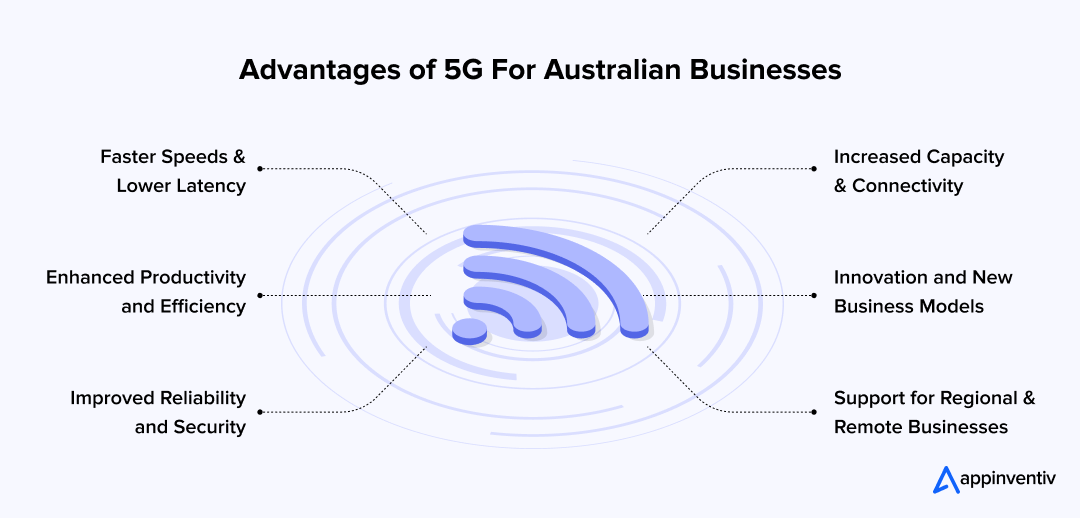
Faster Speeds and Lower Latency
G provides significantly faster data transfer speeds (up to 10 Gbps) and ultra-low latency (as low as 1 millisecond), compared to 4G’s 100-200 milliseconds. This enables app optimizations for 5G networks to communicate and process data. Industries like manufacturing, logistics, and healthcare can leverage real-time data for automation, remote monitoring, and decision-making.
Bonus Read: How Will 5G Networks Impact Your Mobile Apps?
Increased Capacity and Connectivity
The most impactful 5G network use case in mobile app development in Australia is connectivity. 5G networks can handle a massive number of connected devices simultaneously, supporting the growing Internet of Things (IoT) ecosystem. Businesses in agriculture, mining, and logistics can deploy IoT devices (e.g., sensors, drones) to monitor crops, equipment, or supply chains in real time.
Enhanced Productivity and Efficiency
With specific app optimizations for 5G networks, developers are creating apps that were impossible in the past due to network limitations. The high speed and reliability of 5G enable automation and streamline business processes. Manufacturing and mining industries, key sectors in Australia, can deploy 5G-enabled robotics for automated production lines or remote equipment operation in hazardous environments.
Innovation and New Business Models
5G enables emerging technologies like augmented reality (AR), virtual reality (VR), and artificial intelligence (AI) to be integrated into business operations. Retail, real estate, and tourism businesses can offer immersive experiences, such as virtual property tours or interactive customer experiences.
Bonus Read: 5G and AI for businesses
Improved Reliability and Security
5G networks offer enhanced reliability and advanced security features, such as network slicing, which allows businesses to have dedicated, secure network segments. Industries like healthcare and finance can rely on 5G for secure, uninterrupted connectivity for sensitive applications, such as telemedicine or financial transactions.
Support for Regional and Remote Businesses
5G’s ability to provide high-speed connectivity in regional areas helps bridge the digital divide in Australia’s vast geography. Agribusinesses and mining companies in remote areas can access high-speed internet for IoT, automation, and data analytics, previously limited by poor connectivity.
So far, it’s clear that the race isn’t about who builds the fastest; it’s more about who can utilize the infrastructure to transform it into real-world experiences. This involves partnerships, not just with hardware vendors, but also with developers who can translate 5G network use cases into mobile app development in Australia to redefine the user experience.
Engaging with experts who have prior experience in providing mobile app development services in Australia further ensures that your business application is optimized for various devices, operating systems, and use cases.
For instance, a banking firm that combines 5G with AI has the potential to offer real-time fraud prevention, straight within its mobile apps, further reinforcing trust in the financial sector. Similarly, in education, 5G can power interactive virtual classrooms with HD videos and augmented content. Thus, the 5G network impact on Australian businesses is highly evident from the practical use case potentials.
Making Apps Optimized for 5G: What to Know
Consideration of 5G networks in app development is now a necessity. As a business owner, there are some things you need to be aware of from the perspective of a developer. We know that 5G offers high speed, low latency, and massive support for the Internet of Things (IoT). However, there are other considerations as well. Below is a detailed breakdown of the requirements and strategies required for adapting apps for 5G success.
Optimizing App Architecture for 5G Speed/Bandwidth
To offer peak data rates of speed more than 10 Gbps and lower latency, developers utilizing 5G networks in app development must evolve their app architecture to take complete advantage of such enhancements. While traditional apps, built around 4G, often prioritized offline functionality and bandwidth efficiency, the adoption of 5G technology for mobile app development in Australia allows the capacity to handle dense traffic and high data transmission rates.
Developing Scalable Apps for IoT Support
Unlike the previous technological integrations, 5G’s extremely low latency and high bandwidth make it highly suitable for sectors that rely on real-time data from the embedded sensors. This advancement is already transforming Australian industries, further highlighting the 5G network’s impact on Australian businesses.
Utilizing Network Slicing
Network Slicing emerges as a transformative feature among the many benefits of 5G for key Australian industries. It enables the creation of multiple virtual networks on top of a single physical architecture. The benefit is that each “slice” can be specifically tailored to specific requirements circling “low latency”, “high-bandwidth”, and “enhanced security”.
Thus, the 5G network impact on Australian businesses is evident as Australian industries start to leverage network slicing to enhance their operational efficiency. On the other hand, from a developer’s perspective, adapting apps for 5G success involves designing apps that dynamically interact with different network slices based on specific needs.
Thus, 5G technology benefits for businesses in Australia extend to cost savings and good resource allocation when network slicing is implemented.
Steps to Adopt 5G Network in Mobile Apps
Adopting 5G network in mobile app development requires a careful alignment of unique 5G capabilities such as high speed, low latency, multiple device connectivity, and network slicing. The first of the many steps to adopt 5G network in mobile apps is understanding the use case.
Understanding the Use Case
Developers must specify exactly how 5G will improve the app experience. This could entail, among other things, facilitating real-time interactions, providing high-definition (HD) content, and managing devices with high Internet of Things (IoT) usage. Additionally, benefits such as ultra-low latency for AR/VR and autonomous vehicles further underscore the growing impact of 5G on mobile app development in Australia.
Analyzing 5G Network Connectivity
Given that 5G implementation is still in its progressive stage, the next step is to assess 5G availability using location data. An in-depth knowledge of the location-based app’s users’ access points helps guarantee that the app can manage network changes as effectively as possible.
This feature is crucial for enterprise mobile solutions in fields like logistics or agriculture, where uninterrupted communication over long distances is essential. 5G network use cases in mobile app development in Australia are also evident in emerging technologies like AR/VR and autonomous vehicles, where connectivity acts as a significant game changer.
Backend Infrastructure Update
Once target regions and 5G business use cases in Australia are clearly defined, developers must enhance the backend infrastructure. Traditional server setups might not be able to support massive data flows and real-time interactions that 5G requires.
This is where cloud-native, scalable architecture, including edge computing, comes into play. Edge processing enables the efficient handling of latency-sensitive data, thereby reducing the need to access the nearest data center.
Redesigning App Architecture
In addition to the backend, mobile app architecture should also evolve accordingly. Developers adopt modular and scalable frameworks that support adaptive content delivery and real-time streaming. Apps for Australian businesses, whether a construction firm or a hospital offering video-based consultations, must be developed to perform under high loads.
Utilizing data protocols like WebSockets and MQTT helps support high-frequency data exchange, which is especially relevant in IoT-heavy use cases. Such developments further reinforce the impact of 5G on mobile app development in Australia.
Testing in Real 5G Environments
To ensure optimal reliability, the next stage involves extensive testing in actual 5G network settings. Developers can learn how their app is optimized for different 5G speed and connectivity scenarios and what they can do to improve it further to support mission-critical tasks with the least amount of latency and maximum reliability by simulating connectivity conditions and monitoring how features like real-time video and navigation function.
How Appinventiv Can Assist You in Utilizing 5G Network For Your Business
As renowned leaders in mobile app development services in Australia, we are in a prime position to assist Australian companies in realising the promise of 5G networks to spur innovation and efficiency. Australia’s digital landscape is being swiftly transformed by 5G technology, and we take pride in providing comprehensive solutions to make sure your company can easily stay ahead of the curve.
Why Consider Us?
- We have extensive experience in designing and developing mobile applications that are fully optimized for 5G.
- Whether you are building a telehealth platform or a data-heavy IoT solution, our core team of developers and stakeholders ensures that your app’s architecture is built to scale with all the necessary 5G capabilities.
- We work in cohesion with clients across sectors to identify 5G-driven opportunities, and then build custom applications capable of directly solving business challenges using tech like edge computing, AI, etc.
Our cloud-native backend and edge computing architecture help us and our clients leverage the full-scale potential of 5G’s low latency and bandwidth efficiency. Our team is experienced in building 5G-powered apps enhanced with enterprise-grade security and compliance with Australia’s privacy and security standards.
Hence, we don’t just build apps but future-ready solutions that empower Australian businesses to thrive in a 5G-driven economy. Contact us now and discuss your project needs.
FAQs
Q. What is the cost to integrate a 5G network into app development?
A. On average, Australian businesses can expect to invest anywhere between AUD 70,000 to AUD 400,000, or more, for a fully developed 5G enabled mobile application. This cost may be at the lower end, depending on the integration of technology, utilizing only faster media streaming or low-latency messaging. However, more advanced applications that tend to rely on high-end features like edge computing or real-time data processing would additionally require more complex infrastructure and backend systems, thus further increasing the overall cost.
Q. What is the importance of 5G network for mobile apps?
A. 5G is essential to the development of mobile apps. Performance, scalability, and responsiveness are gradually improved by high speeds that are 100 times faster than 4G. Furthermore, 5G enables huge device connectivity, making it ideal for sectors like agriculture, construction, healthcare, and logistics. Because of its low latency, it can be used for autonomous applications, such as virtual gaming and remote monitoring.
Q. How can we enhance the impact or use of 5G in Aussie businesses/startups?
A. 5G must be matched with more practical, sector-specific use cases to increase its impact and use cases for Australian companies. For instance, 5G’s networked sensors and self-governing drones have the potential to drastically change agriculture. In the mining industry, 5G enables safer and more effective operations with autonomous vehicles and real-time equipment diagnostics. Enhancing coverage in rural and regional areas would also be aided by corporate investments and outside government backing.
Q. What are some 5G adoption challenges for Aussie businesses?
A. 5G has its own set of difficulties, even if it presents tremendous potential for Australian companies. The restriction of its coverage area is one important problem. While 5G is being rapidly rolled out in places like Sydney and Melbourne, businesses outside of these areas may face difficulties. Second, a large number of Australian companies still use antiquated IT systems that are incompatible with 5G. This presents a challenge for creating or overseeing 5G-optimized applications. Aside from security and compliance concerns, these two elements represent the main obstacles to 5G adoption for Australian companies.


- In just 2 mins you will get a response
- Your idea is 100% protected by our Non Disclosure Agreement.
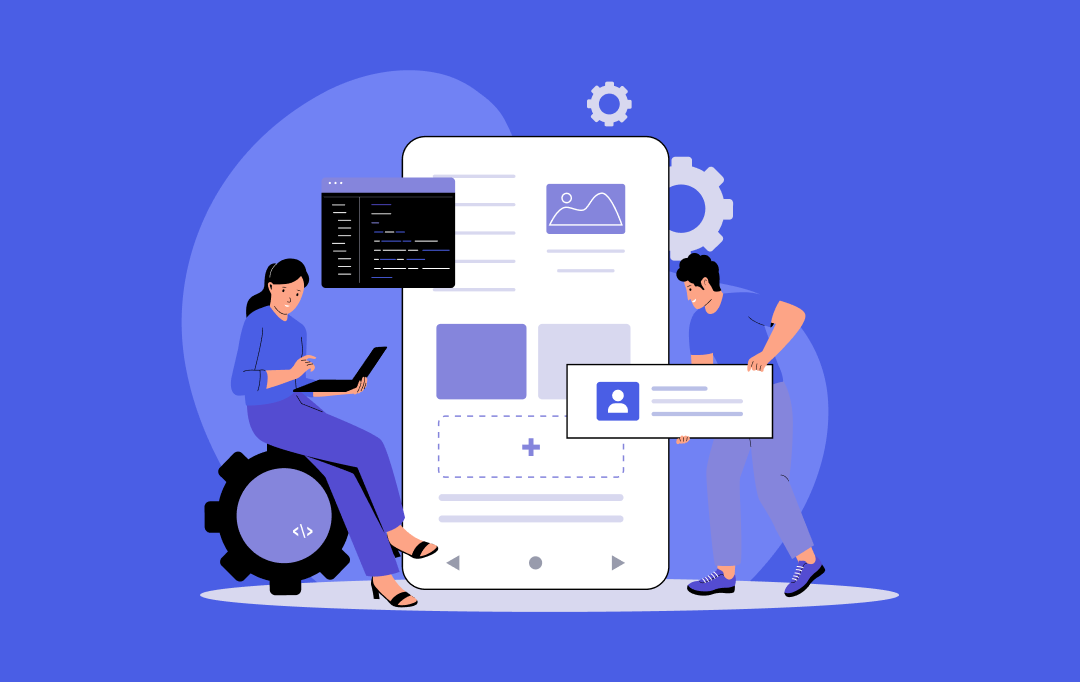
Step-by-Step Guide to Mobile App Development in the Netherlands for Dutch Startups and Enterprises
Key takeaways: The Netherlands’ mobile market is booming, with over 138% mobile penetration. This presents a lucrative opportunity for Dutch startups and enterprises to build secure and scalable apps. Following a structured mobile app development process in the Netherlands helps businesses reduce costs, ensure compliance, and accelerate go-to-market timelines. The costs for custom mobile application…
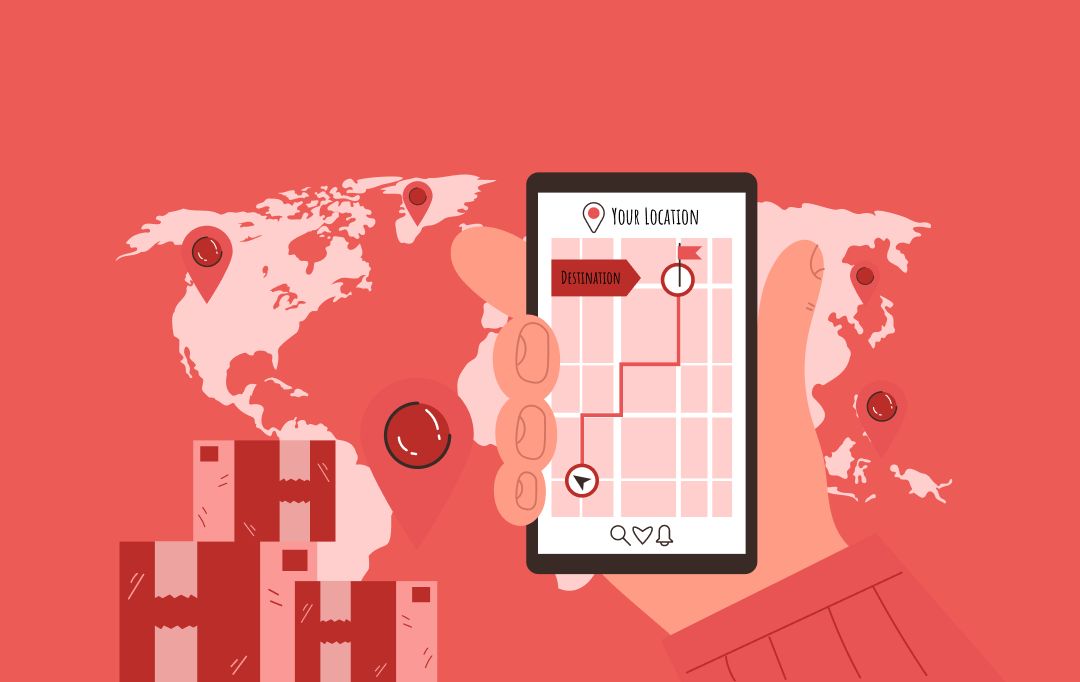
How to Build a Logistics and Transportation App Like Aramex? Step-by-Step Process, Features, Costs
Key takeaways: The UAE and Saudi Arabia are rapidly digitizing logistics, creating strong opportunities for new delivery and fulfillment platforms. Winning in this market requires more than feature parity with Aramex; bilingual UX, COD handling, and PDPL compliance are essential. Advanced capabilities such as smart routing, micro-fulfillment hubs, and predictive analytics drive real operational efficiency.…

How to Build a Secure App in Australia in 2025? All You Need to Know
In today’s hyper-connected world, mobile apps aren’t just conveniences; they are the baseline of modern business. From banking and healthcare to retail and government services, apps power our daily lives. But this digital revolution has a dangerous downside: cyberattacks are escalating alarmingly. More than data exposure, this security breach costs businesses a lot, destroys customer…








